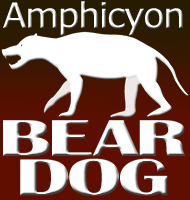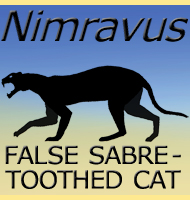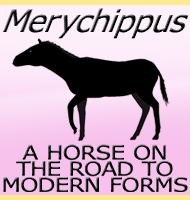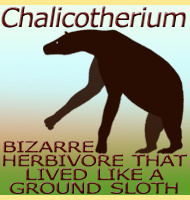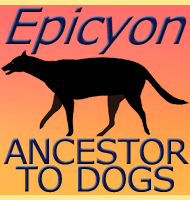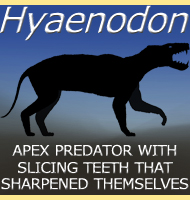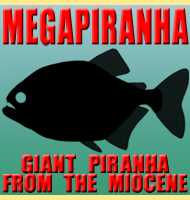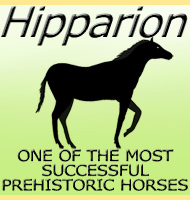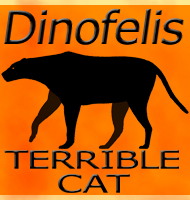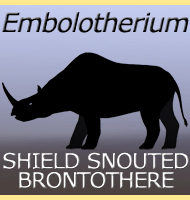


Daeodon
(now includes Dinohyus)
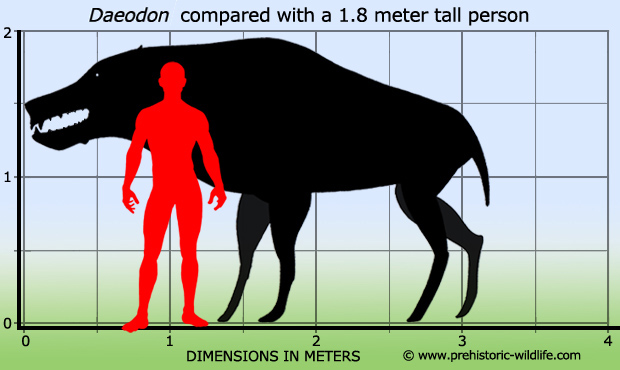
Name: Daeodon
(Hostile tooth - alternatively, Destructive tooth).
Phonetic: Day-oh-don.
Named By: Edward Drinker Cope - 1879.
Synonyms: Ammodon, Boochoerus,
Dinochoerus, Dinohyus.
Classification: Chordata, Mammalia,
Artiodactyla, Entelodontidae.
Species: D. shoshonensis (type).
Diet: Carnivore/Omnivore?
Size: 3.6 meters long, 1.8 meters tall at the
shoulder.
Known locations: North America.
Time period: Aquitanian to Burdigalian of the
Miocene.
Fossil representation: Several specimens.
There
was once another well-known enteledont
called Dinohyus
(terrible
pig) that was once the most well-known of the entelodonts. However
later study towards the end of the twentieth century brought the
realisation that Dinohyus was actually the same as
another genus of
entelodont called Daeodon. Under international
rules governing the
naming of animals, the oldest name has priority by default. This
means that Dinohyus which was named by Peterson in
1905 is now a
synonym to Daeodon which was named twenty-six years
earlier in 1879.
Despite this decision being accepted by palaeontologists for many
years now, there are still some inaccurate sources that continued to
treat Dinohyus as a valid genus even after it was
synonymised with
Daeodon.
Daeodon
was easily one of the largest known entelodonts, although other
genera such as Paraentelodon
as well as the type genus of the
Entelodontidae, Entelodon,
seem to have been comparable in size.
The ninety centimetre long skull of Daeodon is
mostly jaw with two
wide jugals (cheek bones). The wide jugals are thought to have
allowed for the attachment of powerful biting muscles although they
also seem to have been larger in males. This sign of sexual
dimorphism may have been to allow males to have more powerful bites for
fighting with other males, or even making it harder for a rival to
clamp its jaws around its skull, or indeed both.
Because
Daeodon has a mix of different tooth types it has
been imagined to be
an omnivore capable of foraging for plants, particularly certain
parts like roots and tubers, as well as perhaps scavenging carrion,
just like warthogs have been seen to do in Africa today. Although
pig like however, it is still not certain how close entelodonts are
related to pigs, or even if at all. But a carrion scavenger theory
might fit Daeodon better than that of an omnivore.
While easily
capable of killing and equally sized or smaller animal, popular
theories have suggested that entelodonts would track other predators
just to steal their kills, evidence of which come from a zigzagged
entelodont track way that may have been left by an earlier relative of
Daeodon called Archaeotherium.
Further
support for a scavenger theory comes from the arrangement of the
nostrils which in Daeodon seem to have faced out to
the sides rather
than directly forwards. This would allow for the development of a
directional sense of smell since depending upon which direction the
head was facing in relation to the wind, one nostril would pick up a
scent a fraction of a second before the other (similar to how when
you hear a sound you might hear it in one ear before the other,
telling you which way to turn to see what it was). Daeodon
might
have been able to keep on tracking in a zigzag pattern until the point
that the strength of the smell was equal in both nostrils so that it
would then know to just go straight ahead.
Once
a carcass was found it might already have another rival predator
feeding at it, but Daeodon would be to use its
immense bulk to
intimidate and drive another, especially smaller, predator away.
In this scenario it’s likely that by the time that Daeodon
actually
got there most of the choice pieces of flesh would have already been
consumed, but this is where Daeodon would make
real use of the strong
bite force of the jaws. This bite force would have allowed a large
entelodont like Daeodon to break and crack open
bones, especially
when caught between the posterior teeth that were closer to the fulcrum
of the jaw articulation since here the full strength of the jaw closing
muscles could have been brought to bear against whatever was in the
mouth. One final observation that supports a diet of other animals is
not actually on Daeodon itself, but the fossils
of other mammals,
especially herbivores, that have marks on them which closely match
the dental pattern and arrangement of entelodont jaws.
Further reading
- On some of the characters of the Miocene fauna of Oregon. -
Proceedings of the American Philosophical Society 18(102):63-78. - E.
D. Cope - 1878.
- Taxonomy and distribution of Daeodon, an
Oligocene-Miocene entelodont
(Mammalia: Artiodactyla) from North America. - Proceedings of the
Biological Society of Washington. 111 (2): 425–435. - S. G. Lucas, R.
J. Emry & S. E. Foss - 1998.
Random favourites
 |
 |
 |
